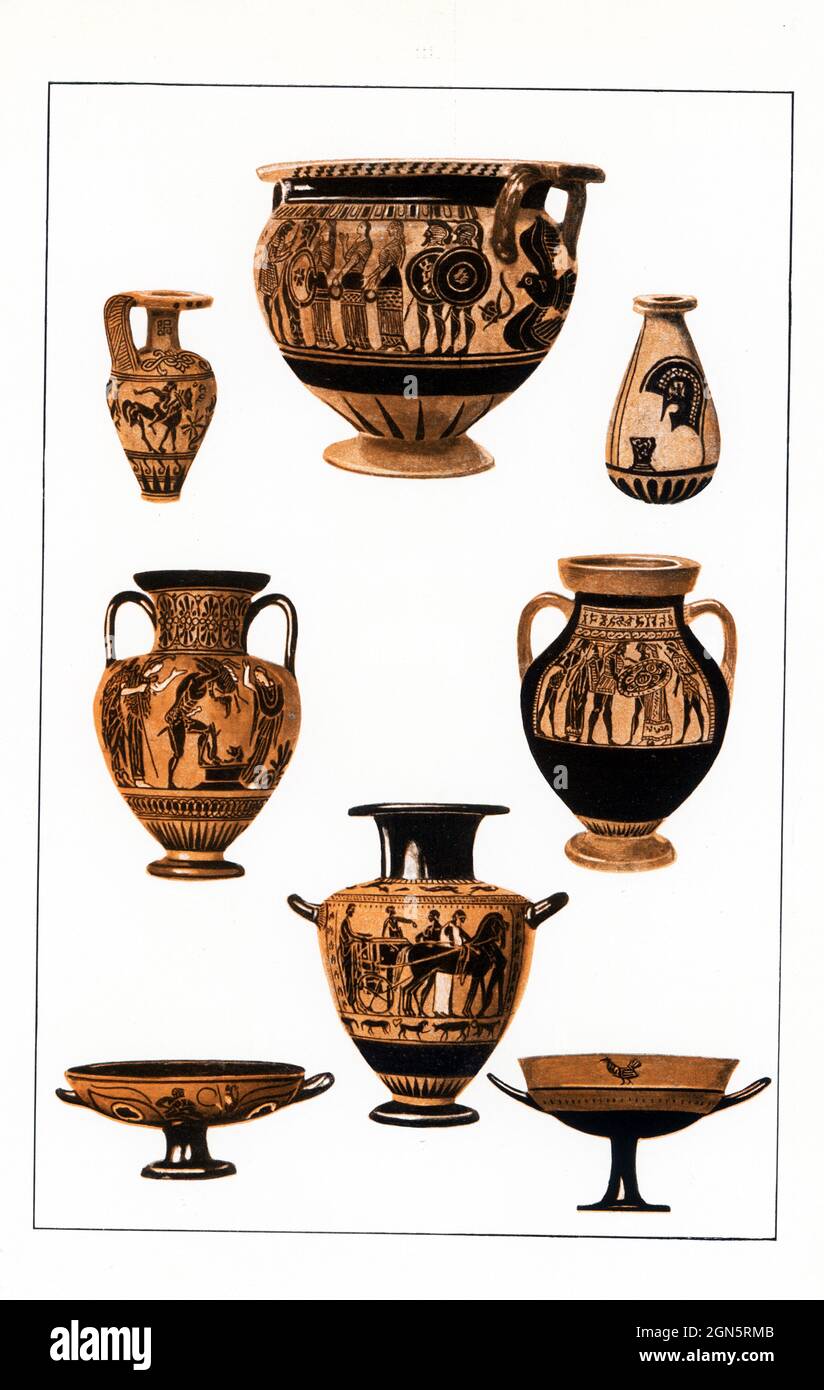But other ancient Greek texts contradict this characterization; Homeric epics describe black people as semi-divine creatures whose country was a relaxing oasis for the gods.[5] Furthermore, visual references on ancient Greek vases depict black people in numerous roles: political allies, musicians, religious worshippers, soldiers, and servants. [6]
Greek Pottery Flashcards | Quizlet
May 3, 2023Which sentence correctly describes black-figure Greek vases: a. the artists made the vases using a hollow-bronze casting method, and then painted the vases. b. the artists filled in the figures with slip, and then carved details with a stylus. c.

Source Image: academic-accelerator.com
Download Image
To produce the characteristic red and black colors found on vases, Greek craftsmen used liquid clay as paint (termed “slip”) and perfected a complicated three-stage firing process. Not only did the pots have to be stacked in the kiln in a specific manner, but the conditions inside had to be precise.

Source Image: journals.uchicago.edu
Download Image
Art of the Hellenistic Age and the Hellenistic Tradition | Essay | The Metropolitan Museum of Art | Heilbrunn Timeline of Art History
2. I use “Black” to refer to the contemporary, socially constructed group of people, and “black” to designate people who are described as having black skin in ancient Greek literature and art. 3. François Lissarrague, “Athenian Image of the Foreigner,” translated by Antonia Nevill.
Source Image: colorado.edu
Download Image
Which Sentence Correctly Describes Black-Figure Greek Vases
2. I use “Black” to refer to the contemporary, socially constructed group of people, and “black” to designate people who are described as having black skin in ancient Greek literature and art. 3. François Lissarrague, “Athenian Image of the Foreigner,” translated by Antonia Nevill.
The black-figure technique developed around 700 B.C. and remained the most popular Greek pottery style until about 530 B.C., when the red-figure technique was developed, eventually surpassing it in popularity.
Black-Figure Vase Painting | Department of Classics | University of Colorado Boulder
The ancient Greek black-figure technique on vase involves painting figures on pottery in glossy black paint. The background, left unpainted, turns red when fired in a kiln. This creates a striking contrast! Artists used this method to tell stories and share scenes from daily life. Created by Getty Museum. Questions Tips & Thanks
How does our concept of beauty today compare to the concept of beauty in Ancient Sparta or Greece? – Quora
Source Image: quora.com
Download Image
Arts | Free Full-Text | The Meaning of the Snake in the Ancient Greek World
The ancient Greek black-figure technique on vase involves painting figures on pottery in glossy black paint. The background, left unpainted, turns red when fired in a kiln. This creates a striking contrast! Artists used this method to tell stories and share scenes from daily life. Created by Getty Museum. Questions Tips & Thanks

Source Image: mdpi.com
Download Image
Greek Pottery Flashcards | Quizlet
But other ancient Greek texts contradict this characterization; Homeric epics describe black people as semi-divine creatures whose country was a relaxing oasis for the gods.[5] Furthermore, visual references on ancient Greek vases depict black people in numerous roles: political allies, musicians, religious worshippers, soldiers, and servants. [6]

Source Image: quizlet.com
Download Image
Art of the Hellenistic Age and the Hellenistic Tradition | Essay | The Metropolitan Museum of Art | Heilbrunn Timeline of Art History
To produce the characteristic red and black colors found on vases, Greek craftsmen used liquid clay as paint (termed “slip”) and perfected a complicated three-stage firing process. Not only did the pots have to be stacked in the kiln in a specific manner, but the conditions inside had to be precise.
Source Image: metmuseum.org
Download Image
Black Figures in Classical Greek Art (article) | Khan Academy
Lastly, he added the handles. In black-figure vase painting, figural and ornamental motifs were applied with a slip that turned black during firing, while the background was left the color of the clay. Vase painters articulated individual forms by incising the slip or by adding white and purple enhancements (mixtures of pigment and clay).

Source Image: khanacademy.org
Download Image
Black figure pottery hi-res stock photography and images – Alamy
2. I use “Black” to refer to the contemporary, socially constructed group of people, and “black” to designate people who are described as having black skin in ancient Greek literature and art. 3. François Lissarrague, “Athenian Image of the Foreigner,” translated by Antonia Nevill.

Source Image: alamy.com
Download Image
Solved: Which sentence correctly describes black-figure Greek vases? The artists painted black sli [algebra]
The black-figure technique developed around 700 B.C. and remained the most popular Greek pottery style until about 530 B.C., when the red-figure technique was developed, eventually surpassing it in popularity.
Source Image: gauthmath.com
Download Image
Arts | Free Full-Text | The Meaning of the Snake in the Ancient Greek World
Solved: Which sentence correctly describes black-figure Greek vases? The artists painted black sli [algebra]
May 3, 2023Which sentence correctly describes black-figure Greek vases: a. the artists made the vases using a hollow-bronze casting method, and then painted the vases. b. the artists filled in the figures with slip, and then carved details with a stylus. c.
Art of the Hellenistic Age and the Hellenistic Tradition | Essay | The Metropolitan Museum of Art | Heilbrunn Timeline of Art History Black figure pottery hi-res stock photography and images – Alamy
Lastly, he added the handles. In black-figure vase painting, figural and ornamental motifs were applied with a slip that turned black during firing, while the background was left the color of the clay. Vase painters articulated individual forms by incising the slip or by adding white and purple enhancements (mixtures of pigment and clay).